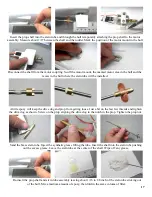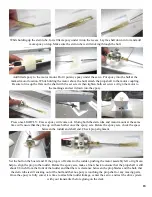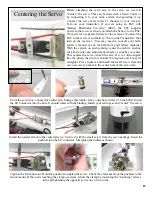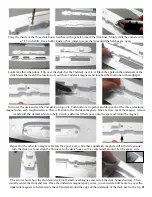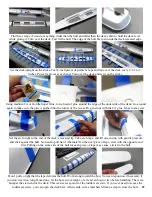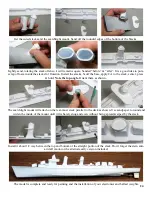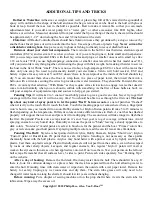
ADDITIONAL TIPS AND TRICKS
Ballast & Waterline:
Adhesive car weights work well. A plastic bag full of bb’s mixed with a spoonfull of
epoxy will conform to the shape of the hull and once the bag is removed, can be fixed to the hull with glue or
hook & loop. Install them as low in the hull as possible. Best to make it removable so that you can made
adjustments later if you add a water pump for a “water gun”, or other accessories like LED Lights, other
batteries or switches. Measured downward from just under the lip overhang of the deck, the waterline should
be approximately 1-1/2” down along the bow and 5/8 inch down at the stern.
Flotation:
All Radio Controlled boats should have flotation in case they get dunked by a dog or run over by
another boat. Insert pieces of swim noodle into the bow. Use scraps of foam or plastic bags.
Never swim after
a disabled or sinking boat.
Keep a recovery tugboat or fishing rod handy to recover disabled boats.
Decisions about your electrical components.
There is room in the hull for most batteries, electronic speed
controllers (ESC’s) and receivers. Use what you have or if you are buying new, think small and inexpensive.
Will you use large waterproofed ESCs with their big wires and plugs, or smaller ones used in small toys like
1:18 scale cars? Will you use high-amperage connectors or smaller ones rated for what this model uses? Or,
will you just solder everything together, eliminating the plugs with their weight, but making it harder to service
the boat in the field. Think “small”. There is no need to buy a high-amperage ESC for a boat with a motor that
draw only one amp. No need to permanently install your electronics. Velcro will hold receiver, ESC and
battery in place for easy removal. Your ESC doesn’t have to be waterproof as the inside of the hull should stay
dry. You can mount them above the floor or wrap them in a piece of paper towel, then insert them into a
balloon with a twist-tie securing the wires to provide some water resistance. They should be Forward-Reverse
ESCs. Avoid any that advertise “With Brake” as they require extra stick action to engage reverse that doesn’t
come to mind naturally when you are about to collide with something. As the first of these hulls are built, we
will post examples of equipment setups and sources to help get you started.
Painting Tips:
It will take 2 to 3 coats of most hobby paints to give a good even color. Never try to get full
coverage with the first coat. It will run every time! You should be able to see through the first coat.
The best
tip about any kind of spray paint is to
let the paint “flash” between coats.
A coat of paint has “flashed”
when it is dry to the touch. Don’t touch the boat. Touch the masking paper or somewhere where a fingerprint
won’t show in case you touched it too soon. Hobby enamel or Krylon Fusion paint will take 5 to 15 minutes to
flash depending on the temperature. Different colors can take different times to flash. A coat that has flashed
properly will support the next coat and prevent it from dripping. The second coat will take longer to flash than
the first. Be patient! Practice on a scrap stood on it’s end. Your goal is to get coverage without runs. Avoid
spraying enamel on very humid days. Humidity can cause the paint to “blush” leaving a cloudy appearance to
dark colors. “Non-toxic” model paints are safest to brush on, for the painter and the boat. “Primer” colors like
grey or red can make good hull paints. If spraying multiple colors, read the can for recoat time limitations.
Painting The Hull:
Styrene is best painted with Acrylics, Hobby Enamels, Krylon “Short Cuts”, Krylon
“Fusion” paint or Rust-Oleum 2X paint that is safe for plastic. Sanding is not necessary as these paints
chemically bond with the hull plastic. Acrylics may bond better with a primer coat or by lightly scuffing the
plastic. Test them on plastic scraps. Plastic-friendly enamels will not peel from the surface, even when scraped
by rocks or other sharp objects. Lacquers and regular enamels, like regular “Krylon” paints will melt or
weaken the styrene in thin areas or when applied wet-on-wet. Don’t use them. Test your paints on the leftover
hull scraps. Remember that all surfaces have 5 sides to paint. Paint each side separately. See “Painting Tips”
on the website.
After a day of boating:
Remove the 2nd deck. Drain any water from the hull. There shouldn’t be any. If
there is, look for collision damage or a place where the deck has separated from the hull allowing water to
enter the hull. If muddy, rinse with clean water or wipe down the outside with a wet paper towel. Remove the
battery for safety. Unplug any wet connectors and dry them. The stern tube grease will only need to be
changed if water leaks in along the shafts. It should last for years without changing.
Before running:
Put a droplet of sewing machine oil on the prop shaft where it exits the stern tube for
lubrication. Wipe away the excess oil.
Copyright © 2018 Philip Pace, d.b.a. Vac-U-Boat
TM







